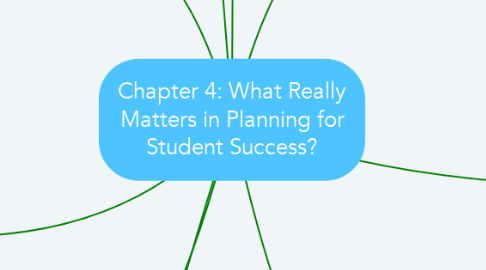Chapter 4: What Really Matters in Planning for Student Success?
by Nicole Bergquist

1. Developed classroom management routines that contribute to success
1.1. Does the teacher have a vision for a smoothly-running classroom?
1.2. Does the teacher collaborate with students to make classroom rules?
1.3. Does the teacher know the classroom dynamics and how specific students relate to each other?
1.4. Is the teacher ensuring all students' participation?
1.5. Create and monitor classroom jobs?
2. Flexible classrooms teaching routines
2.1. Is the teacher allowing for students' varied paces of learning?
2.2. Is the teacher using materials that are varied in culture, interest, mode, medium, and difficulty level?
2.3. Is the teacher teaching to the whole class, small groups, and individuals?
2.4. Is the teacher experimenting with classroom setup to aid in student learning?
2.5. Is the teacher varying student groupings?
2.6. Do grades reflect the students' personal growth and standing in regards to specific learning outcomes?
3. Expanded repertoire of instructional strategies
3.1. Is the teacher using a wide variety of instructional strategies in explaining and exploring the material?
3.2. Is the teacher guiding students in their work with each new strategy?
3.3. Is the teacher helping students to reflect up on and problem solve which strategies work best for them and why?
4. Aided students in becoming partners in their own success
4.1. Does the teacher nurture understanding of students' specific strengths?
4.2. Are the students asked to reflect on their own strengths and weaknesses and performance?
4.3. Does the teacher support students in creating their own strategies for learning?
4.4. Does the teacher provide opportunities for students to discuss growth and goals with their families?
5. Built awareness of what works for each student
5.1. Is the teacher communicating with each individual learner?
5.2. Is the teacher showing interest in each students' aspirations and interests?
5.3. Does the teacher know each students' strengths and weaknesses?
5.4. Does the teacher know the variance of students that they teach?
5.5. Are opportunities opened for communication with students' parents and communities?
6. Established clarity about curricular essentials
6.1. Is the teacher clear on what the students ought to know?
6.2. Do the students know what is important?
6.3. Are they developing solid frameworks of meaning?
6.4. Is curriculum based on enduring understanding?
7. Reflection on individual progress with an eye towards curricular goals and personal growth
7.1. Is the teacher using pre-assessment data to plan for individual and classroom-wide success in meeting the outcomes?
7.2. Is the teacher constantly working to ensure that the instructional strategies are meeting students' needs?
7.3. Is the teacher tracking student growth in regard to classroom-wide goals?
7.4. Is the teacher including families in this process?
8. Accepted responsibility for learner success
8.1. Is the teacher getting know each student individually?
8.2. Is the teacher giving up when students struggle, or placing the blame on them?
8.3. Is the teacher tracking student progress and comparing it to essential outcomes?
8.4. Is the teacher finding alternate ways of teaching the material?
8.5. Do the students know that the teacher will keep working until they understand?
8.6. Is the teacher showing the process and end goal of activities and projects clearly?
9. Developed communities of respect
9.1. Is the teacher modeling respect towards everyone?
9.2. Is the teacher seeking out each student's assets and affirming them?
9.3. Is the teacher designing projects that pull from these unique assets?
9.4. Is the teacher encouraging and outwardly valuing multiple perspectives?
9.5. Are all students called upon regularly in class to share their thoughts?
9.6. Are students reflecting on their contributions to the classroom?


